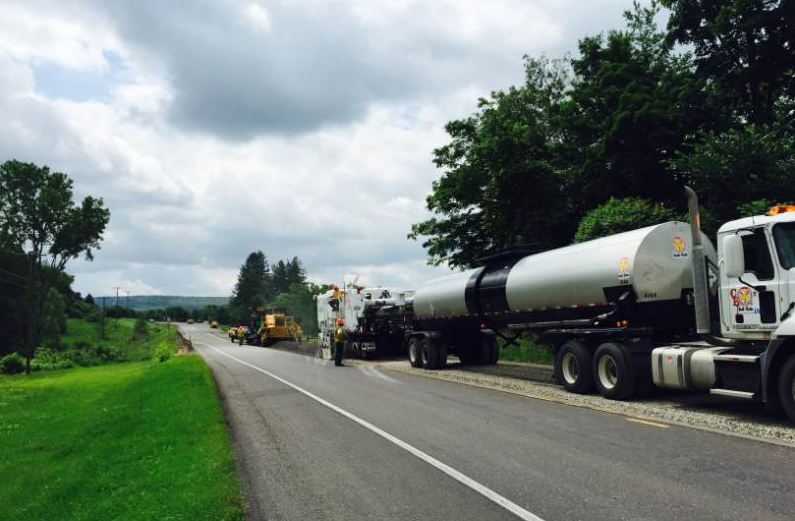Suit-Kote Recycles Hwy 243
BY Jeff Winke

If state roads were people, New York State Highway 243 would be considered a good ol’ friend—always there when you need him. It’s been a utilitarian, single-lane divided highway of 11.03 miles since 1930 stretching east to west between an intersection at NY 98 in the town of Freedom and a junction with NY 19 in the town of Caneadea.
In 2014, the New York Department of Transportation put out for bid the rehab of 6.6 miles of NY 243 because the road surface had finally aged, displaying transverse and longitudinal cracking. Suit-Kote Corporation, headquartered in Cortland, New York, won the portion of the contract that called for cold in place recycling of the base with a value of $850,000.
Founded in 1921, Suit-Kote is a medium-size, privately-owned asphalt products manufacturer, as well as road construction, maintenance and asphalt applications engineering company that serves the Northeast through its 15 locations in New York and Pennsylvania. Suit-Kote principally focuses on roadwork projects. During peak season, the company has 750 employees and maintains a diverse equipment fleet of 21 asphalt pavers, 4 stabilizers and 12 milling machines. Twelve employees were devoted to the NY 243 project, which measured 22 feet across with 4-foot shoulders on each side and a milling depth of 4.5 inches. With those measurements, the crew milled and recycled a total of 143,000 square yards.
“For the Highway 243 project, [we used] a modified Roadtec RX-900e milling machine to do single unit cold in place recycling,” Zeke Quinlan, vice president of operations for Suit-Kote Corporation stated. The completely fabricated, welded and assembled machine frame is 1.5 feet wider to provide the stability the crew needs from a machine that doesn’t use a conveyor.
The company elected to use CIR with high float emulsion because it “helps with coating and improves wintertime freeze/thaw performance by providing a mat with greater flexibility,” according to Quinlan. The RX-900e milled a depth a 4.5 inches as it traveled forward. Because the modified machine doesn’t have a conveyor, the aggregate millings with a chemically-stabilized emulsion binder were discharged directly to the roadway in a windrow.
Within a matter of minutes, an Ingersoll-Rand ABG Titan 525 paver from Volvo Construction Equipment with a windrow pickup machine collected the material and placed it as the 4.5-inch CIR base course. After the emulsion had set—which took approximately 10 days—another contractor placed a 2-inch overlay of hot-mix asphalt finish course.
With input from Suit-Kote, Roadtec performed much of the cold planer modifications to create the custom CIR machine.
“We made some modifications to fit our needs,” Quinlan said. “Achieving the right weight distribution was a big factor for us, especially with the machine not having a heavy-duty conveyor system.”
Near the end of the project, Zeke Quinlan reflected: “Our goal is always to end our project knowing we played a role in creating a highway with a smooth ride. It feels good to know that the people who depend on this 6.6-mile stretch will have a good highway for years to come.”
